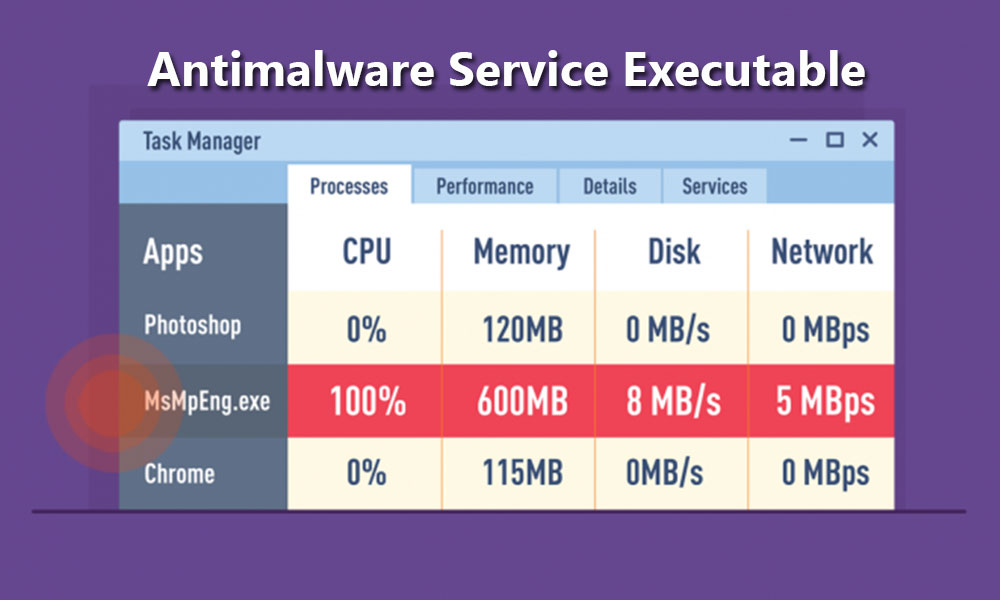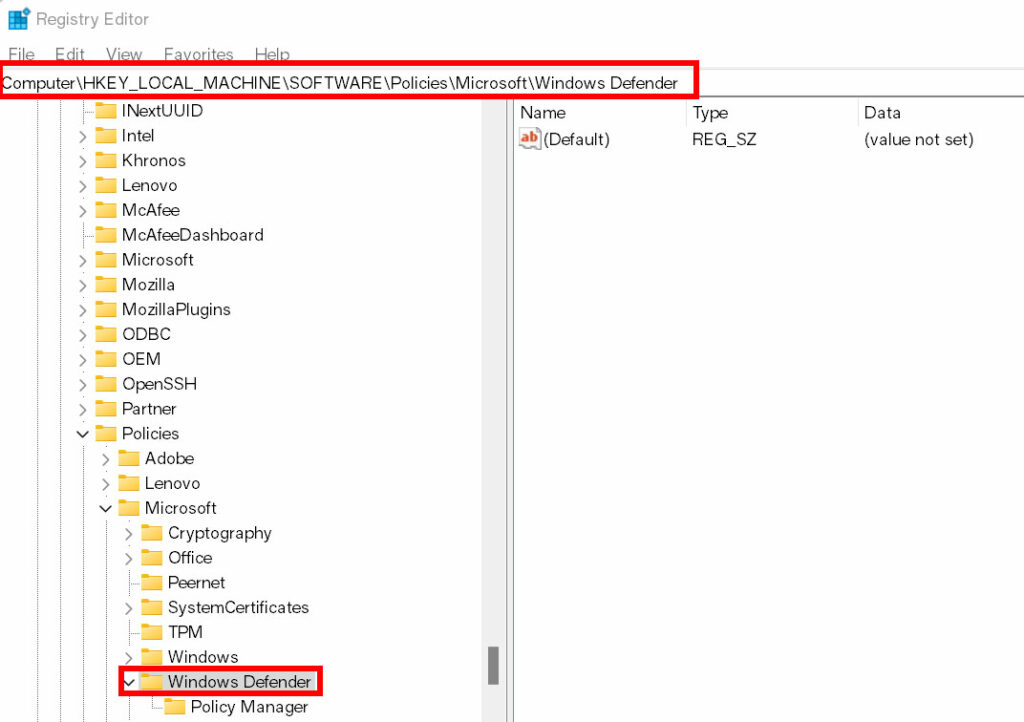In the Windows Task Manager, you may notice the process MsMpEng.exe called “Antimalware Service Executable”. Most of the time, it runs in the background with a high CPU load. Here in this guide, we will share with you the reasons and possible steps to Fix Antimalware Service Executable high usage of the system resources. The process plays an important role in the Windows Defender Service that comes preloaded with Windows 10 OS.
Additionally, if you’re a Windows Defender user then you may occasionally notice that process running in the background. But fortunately, it can be fixed easily. If the “Antimalware Service Executable” is running in the background processes, your PC may work slower than expected. In most scenarios, the anti-virus program is running in the background and if you disable the real-time protection, it may help.
Also Read
How to Fix White Screen of Death in Windows 11/10
Fix: Windows Defender Firewall Rule is Blocking Your Connection
How to fix Windows Defender error code 0x800b0100
Fix: Micro SD Not Showing Up on Windows 10/11
Download Dolby Audio Driver for Windows 11/10/8.1
How To Fix External Hard Drive I/O Device Error in Windows 11/10
Fix: Win+Shift+S Not Working on Windows 11/10
Fix: Apple Magic Keyboard Not Showing Up in Windows 10 / 11
Fix: Windows LSASS Local Service Authority Protection Error In Windows Defender Security
Page Contents
- What is Antimalware Service Executable?
- Steps to Disable or Fix Antimalware Service Executable
- 1. Disable Real-time Protection
- 2. Change Windows Defender Scheduling Options
- 3. Exclude MsMpEng.exe from Windows Defender
- 4. Disable Windows Defender in Registry Editor
- 5. Disable Windows Defender in Local Group Policy Editor
- 6. Update Device Drivers on Windows 10
- 7. Remove Bad Updates
- 8. Disable Process Mitigations
- 9. Try Using Another Anti-Virus Software
What is Antimalware Service Executable?
The Antimalware Service Executable process plays an important role in the Windows Defender Service that comes preloaded with the Windows 10 OS. However, it consumes too much CPU and RAM usage which basically reduces the system performance. Therefore, the chances are high that you may experience multiple issues with the opening or running programs on your Windows 10 computer.
If you use the Windows Defender program to secure your PC/Laptop as anti-virus software, then you can notice it. Just open the Task Manager directly from the Taskbar or press Ctrl + Shift + Esc buttons together. Now, you will see a background process called msmpeng.exe respectively.

Must Read: Forgot Windows 10 password? Easy Way to Reset it
This process allows the Windows Defender tool to continuously monitor your PC for potential threats and provide real-time protection against malware and cyber attacks easily. This doesn’t slow down your computer that much as compared to the other third-party anti-virus applications. However, it can consume a huge CPU load.
Steps to Disable or Fix Antimalware Service Executable
If you use the Windows Defender tool then you may set the drive scanning timings or scan the required drives. Whenever it scans deeply of your whole drives, it may take higher CPU usage. But if you don’t want to run it in the background all the time, you can turn it off as well. Follow the guide mentioned below:
1. Disable Real-time Protection
It’s highly reported that by disabling the real-time protection on the Windows Defender program, most of the affected users have fixed the particular issue. So, you should follow the steps below to fix this issue.
- Open the Settings menu by pressing Windows + I keys.
- Go to Update and Security > Select Windows Defender and open it.
- Click on the shield icon on the left side > go to Virus and threat protection settings.
- Now, you can turn off real-time protection and cloud-based protection.
- You can now check out whether the problem has been fixed or not.
2. Change Windows Defender Scheduling Options
Well, it seems that changing the Windows Defender schedule option can prevent the Antimalware Service Executable high disk usage issue properly. To do so:
- Press Windows + R keys to open the Run dialog box.
- Type taskschd.msc and press Enter.
- Double-click on “Task Scheduler Library” > Click on “Microsoft”.
- Click on “Windows” > Now, find and click on “Windows Defender” to expand it.
- Next, double-click on “Windows Defender Scheduled Scan”.
- Make sure to uncheck the “Run with highest privileges” checkbox on the property window.
- Then uncheck all the items in the “Conditions” section.
- Finally, click on “OK” to save changes.
3. Exclude MsMpEng.exe from Windows Defender
If in case, you don’t want to turn off the real-time protection on your Windows Defender program then make sure to exclude the MsMpEng.exe process to the exclusion list to resolve such an issue. To do so:
- Press the Windows + I keys to open the Windows Settings menu.
- Click on “Update & security” > Click on “Windows Defender”.
- Next, click on “Add an exclusion” from the Exclusions section.
- Click on “Exclude a .exe, .com or .scr process”.
- Now, type MsMpEng.exe and click on “OK”.
4. Disable Windows Defender in Registry Editor
Whenever your Windows Defender got corrupted due to some unexpected reasons, the Antimalware Service Executable may consume higher CPU/Memory usage. Luckily, this particular issue can be fixed by disabling Windows Defender from the Registry Editor. To do this:
- Press Windows + R keys to open the Run dialog box.
- Type regedit and click “OK” to open the Registry Editor.
- If prompted by UAC, click on Yes to grant admin access and proceed.
- From the navigation pane on the left side, double-click on the HKEY_LOCAL_MACHINE\SOFTWARE\Policies\Microsoft\Windows Defender to expand the list.

- Here if you find a registry entry called ‘DisableAntiSpyware’, just double-click on it.
- Make sure to set its Value Data to 1.
However, if you do not see a registry entry ‘DisableAntiSpyware’, then make sure to do the following steps:
- Right-click on the main Registry Editor pane and select “New” > “DWORD (32 bit) Value”.
- Name it DisableAntiSpyware > Double-click on it and set its Value Data to 1.
- Close the Registry Editor window > Restart your computer to apply changes.
5. Disable Windows Defender in Local Group Policy Editor
If you’re using the Windows 10 OS Enterprise or Professional or Education edition then you’ll have to follow this method to disable the Windows Defender key. To do that:
- Press the Windows + R keys to open the Run dialog box.
- Type gpedit.msc and click OK to open the Local Group Policy Editor.
- From the Local Group Policy Editor interface, just navigate to Computer Configuration > Administrative Templates > Windows Components > Windows Defender.
- Here you’ll be able to see the “Turn off Windows Defender” option.
- Just double-click on it to open the list > Select the Enabled option to disable Windows Defender.
- Now, click on Apply then OK to save changes.
- Finally, close the window and restart your computer to check if that fixes the Antimalware Service Executable high CPU or Memory usage issue or not.
6. Update Device Drivers on Windows 10
It’s also worth mentioning that if some of the device drivers are outdated or corrupted then your Windows 10 computer may run slowly. So, make sure to keep your device drivers up-to-date. Either you can simply visit the manufacturer’s website and download the latest driver from your specific device model then install it or head over to Device Manager and check for the available updates.
7. Remove Bad Updates
The chances are high enough that your Windows Defender program has recently installed a bad or buggy update which seems to be one of the major reasons behind such an issue. Therefore, using the command prompt should resolve the problem.
- Press Windows + R keys to open the Run dialog box.
- Now, type cmd and press Shift + Ctrl + Enter keys together to give an administrative privilege to the command prompt.
- Then make sure to click on Yes if prompted by UAC to grant the permission.
- Type the following command line and hit Enter:
"%PROGRAMFILES%\Windows Defender\MPCMDRUN.exe" -RemoveDefinitions -All
- Next, execute the following command line:
"%PROGRAMFILES%\Windows Defender\MPCMDRUN.exe" -SignatureUpdate
- Wait for the process to complete and then check if the issue persists or not.
8. Disable Process Mitigations
- Press the Windows + X keys to open the Quick Access Menu.
- Click on Command Prompt (Admin) or PowerShell (Admin).
- If prompted by UAC, click on Yes to proceed.
- Now, copy and paste the following command line into the command prompt window:
powershell “ForEach($v in (Get-Command -Name \”Set-ProcessMitigation\”).Parameters[\”Disable\”].Attributes.ValidValues){Set-ProcessMitigation -System -Disable $v.ToString().Replace(\” \”, \”\”).Replace(\”`n\”, \”\”) -ErrorAction SilentlyContinue}”
- Now, press Enter to disable Exploit Protection on your Windows 10 PC.
- If any warnings or prompts appear, just ignore them and let the process complete.
- Finally, restart your computer to apply changes.
9. Try Using Another Anti-Virus Software
If nothing seems working for you, try using another anti-virus protection on your computer. There are multiple reliable anti-virus programs available online that you can use for free. In that sense, you’ll also be able to find out if there is any malware or virus affecting the system performance or not by simply running the full scan.
We’ll recommend you using ‘Malwarebytes’ or any other less aggressive anti-virus software as compared to Windows Defender or some other highly aggressive protection software.
It’s also worth mentioning that using any other antivirus program will basically disable the Windows Defender by default which means there may be a valid chance to fix the Antimalware Service Executable higher disk usage issue.
You can write down your problems or experience regarding this issue.
